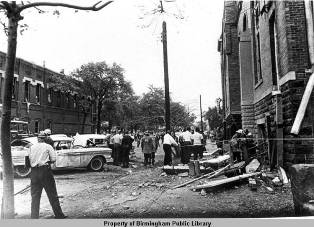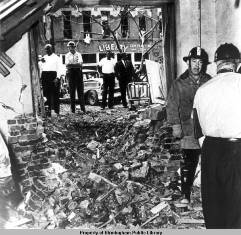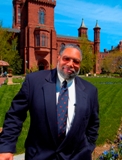This is a newsletter that was emailed today from the National Museum of African American History and Culture:
Lonnie
Bunch, museum director, historian, lecturer, and author, is proud to present
A Page from Our American Story, a
regular on-line series for Museum supporters. It will showcase individuals and
events in the African American experience, placing these stories in the context
of a larger story — our American story.
A
Page From Our American Story
On September 15, 1963, an explosion shattered the quiet of a Sunday morning,
blowing apart the 16th Street Baptist Church in Birmingham, Alabama.
Four young girls who were getting ready for Sunday School were killed almost
instantly.
Denise McNair, 11, Addie Mae Collins, 14, Carole Robertson, 14, and Cynthia
Wesley, 14 died as a result of a bomb placed under the church by members of the
Ku Klux Klan. Twenty-two others, including Collins' younger sister Sarah, were
injured.
“I remember Denise asking Addie to tie her belt,” Sarah Collins Cox said in
an interview. “And then it happened.”
Most Americans had little idea, or had paid little attention to the fact that
Birmingham had been the scene of more than 50 bombings between 1947 and 1963.
This bombing, however, would not go unnoticed. The murderous event
awakened the nation and effectively galvanized the civil rights
movement.
In the months leading up to the bombing, Birmingham had become the focal
point of the civil rights front. The city was all too familiar with racial
violence. Both African Americans and moderate whites had been long terrorized by
the Klan.
.
Years earlier, Birmingham minister Fred L. Shuttlesworth founded the Alabama Christian Movement for Human Rights (ACMHR) to directly confront racism and segregation in the city. In the spring of 1963, Shuttlesworth's group joined forces with Dr. Martin Luther King, Jr., and his Southern Christian Leadership Conference (SCLC), the largest and best known organization fighting for equal rights at the time. Together, the men formulated a plan that called for months-long protests to end segregation in Birmingham
In May of that year, after weeks of marches, sit-ins, boycotts, bus strikes,
and prayer vigils, an agreement was reached. It had the input of local
government leaders, white business owners, African American leaders and civil
rights groups. The city would actively begin working toward integration. The
agreement did not sit well with segregationists, among the most violent of which
was the notorious KKK.
Riots erupted during the summer months, and nightly newscasts revealed to the
rest of America the lengths to which Southern racists like Governor George
Wallace and Birmingham's Commissioner of Public Safety Eugene “Bull” Conner
would go in their fight to keep the South segregated.
Conner ran Birmingham's police and fire departments, and his ruthless tactics
against the demonstrators shocked the country. With each evening's news,
Americans watched as Conner's police used attack dogs, billy clubs, and tear gas
on the peaceful protestors. He turned fire hoses on the crowd with water
pressure so high it would “peel away skin,” according to press
reports.
Still, it was the 16th Street Baptist Church and the deaths of
four innocent children that finally snapped the nation and the federal
government into action. All over the country, citizens became angry and ready
for change. In June 1963, President John Kennedy introduced a civil rights bill,
now known as the 1964 Civil Rights Act, to widespread support.
The 16th Street Baptist Church bombing is cited by many historians
as the turning point in the civil rights movement. An editorial in the Milwaukee
Sentinel said the bombing should “serve to goad the conscience” of the country.
“The deaths...in a sense are on the hands of each of us.”
We should always keep in mind that the four girls who died, while
immortalized in history, were children with children's dreams. Carol Robertson
was a straight A student who loved to dance. Cynthia Wesley excelled in math.
Addie Mae Collins was quiet, athletic, and had a flare for art. Denise McNair
wrote plays for the kids in her neighborhood.
History is not scripted. In the case of the 16th Street Baptist
Church bombing it was shaped out of racist hatred that ended four innocent
lives, but changed America forever.
|

Welcome! This free speech community journal was created so the Maple Heights African American community could share videos, photos, events, articles, posts, ideas, thoughts, and information. We're now exclusively on Facebook, so don't forget to also check out our Facebook page. Have a fantastic day!
Friday, September 14, 2012
16TH STREET BAPTIST CHURCH BOMBING IN BIRMINGHAM
Subscribe to:
Post Comments (Atom)




No comments:
Post a Comment